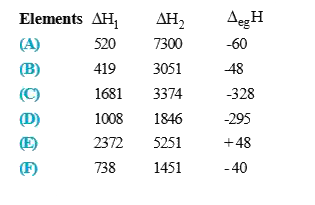Among the elements of second period pick out the element
that is the most reactive metal.
To determine the most reactive metal among the elements of the second period, we can follow these steps:
Step 1: Identify the Elements in the Second Period
The elements in the second period of the periodic table are:
- Lithium (Li)
- Beryllium (Be)
- Boron (B)
- Carbon (C)
- Nitrogen (N)
- Oxygen (O)
- Fluorine (F)
- Neon (Ne)
Step 2: Classify the Elements as Metals or Non-Metals
In the second period, the elements can be classified as follows:
- Metals: Lithium (Li), Beryllium (Be)
- Metalloids: Boron (B)
- Non-metals: Carbon (C), Nitrogen (N), Oxygen (O), Fluorine (F), Neon (Ne)
Step 3: Determine Reactivity of Metals
Among the metals in the second period, we need to evaluate their reactivity. Reactivity in metals generally increases as you move down a group in the periodic table, but for the second period, we focus on the two metals present: Lithium and Beryllium.
Step 4: Analyze the Electronic Configuration
- Lithium (Li) has the electronic configuration of 1s² 2s¹.
- Beryllium (Be) has the electronic configuration of 1s² 2s².
Step 5: Assess the Reactivity of Lithium
Lithium has one valence electron in its outermost shell (2s¹). This single electron can be easily lost to achieve a stable electronic configuration (1s²), resembling that of the noble gas helium. This makes lithium highly reactive as it readily participates in chemical reactions.
Step 6: Assess the Reactivity of Beryllium
Beryllium, on the other hand, has two valence electrons (2s²). While it can also lose electrons to form compounds, it does so less readily than lithium because it requires more energy to remove both electrons.
Conclusion
Based on the analysis, Lithium (Li) is the most reactive metal in the second period due to its single valence electron, which it can easily lose to achieve a stable electronic configuration.
Final Answer
The most reactive metal in the second period is Lithium (Li).
---
The elements in the second period of the periodic table are:
- Lithium (Li)
- Beryllium (Be)
- Boron (B)
- Carbon (C)
- Nitrogen (N)
- Oxygen (O)
- Fluorine (F)
- Neon (Ne)
In the second period, the elements can be classified as follows:
- Metals: Lithium (Li), Beryllium (Be)
- Metalloids: Boron (B)
- Non-metals: Carbon (C), Nitrogen (N), Oxygen (O), Fluorine (F), Neon (Ne)
Among the metals in the second period, we need to evaluate their reactivity. Reactivity in metals generally increases as you move down a group in the periodic table, but for the second period, we focus on the two metals present: Lithium and Beryllium.
- Lithium (Li) has the electronic configuration of 1s² 2s¹.
- Beryllium (Be) has the electronic configuration of 1s² 2s².
Lithium has one valence electron in its outermost shell (2s¹). This single electron can be easily lost to achieve a stable electronic configuration (1s²), resembling that of the noble gas helium. This makes lithium highly reactive as it readily participates in chemical reactions.
Beryllium, on the other hand, has two valence electrons (2s²). While it can also lose electrons to form compounds, it does so less readily than lithium because it requires more energy to remove both electrons.
Based on the analysis, Lithium (Li) is the most reactive metal in the second period due to its single valence electron, which it can easily lose to achieve a stable electronic configuration.
The most reactive metal in the second period is Lithium (Li).
Topper's Solved these Questions
- CLASSIFICATION OF ELEMENTS AND PERIODICITY IN PROPERTIESBOOK - ICSECHAPTER - CLASSIFICATION OF ELEMENTS AND PERIODICITY IN PROPERTIESEXERCISE - ESSAY (LONG ANSWER) TYPE QUESTIONS
27 Videos
- CLASSIFICATION OF ELEMENTS AND PERIODICITY IN PROPERTIESBOOK - ICSECHAPTER - CLASSIFICATION OF ELEMENTS AND PERIODICITY IN PROPERTIESEXERCISE - OBJECTIVE (MULTIPLE CHOICE) TYPE QUESTIONS
54 Videos
- CLASSIFICATION OF ELEMENTS AND PERIODICITY IN PROPERTIESBOOK - ICSECHAPTER - CLASSIFICATION OF ELEMENTS AND PERIODICITY IN PROPERTIESEXERCISE - VERY SHORT ANSWER TYPE QUESTIONS
25 Videos
- CHEMICAL THERMODYNAMICS BOOK - ICSECHAPTER - CHEMICAL THERMODYNAMICS EXERCISE - NCERT TEXT-BOOK. EXERCISES
22 Videos
- ENVIRONMENTAL CHEMISTRY BOOK - ICSECHAPTER - ENVIRONMENTAL CHEMISTRY EXERCISE - NCERT TEXT-BOOK EXERCISE
20 Videos
Similar Questions
Among the elements of second period pick out the element
that is the most reactive non- metal.
View SolutionAmong the elements of second period pick out the element
with the most negative electron gain enthalpy
View SolutionAmong the elements of second period pick out the element
with the most negative electron gain enthalpy
View SolutionAmong the elements of second period pick out the element
with the largest atomic radius.
View SolutionAmong the elements of the third period (Na to Ar), pick out the element
that is the most reactive metal.
View SolutionAmong the elements of the third period (Na to Ar), pick out the element
that is the most reactive non metal.
View SolutionAmong the elements of the third period (Na to Ar), pick out the element
with the largest atomic radius.
View SolutionThe first and second ionization enthalpies and electron gain enthalpy of some elements are as given below:

Which of these elements is the most reactive metal?
View SolutionAmong the elements of the third period (Na to Ar), pick out the element
with the highest first ionization enthalpy.
View SolutionThe first and second ionization enthalpies and electron gain enthalpy of some elements are as given below:

Which of these elements is the most reactive non-metal?
View Solution
